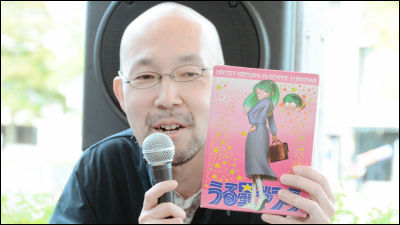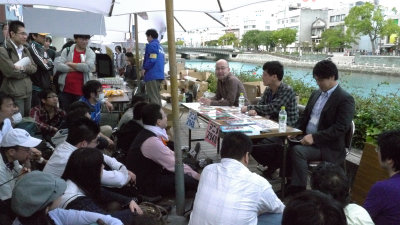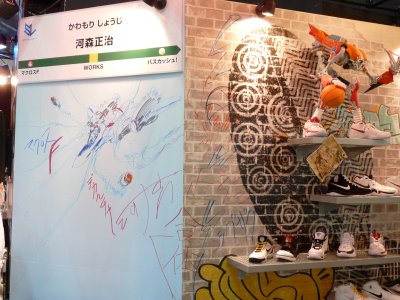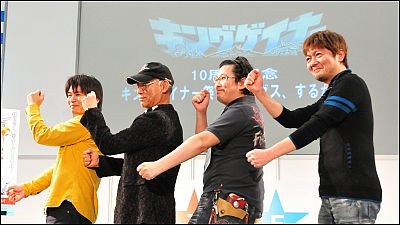'Don't just look at pictures of figures, you have to see and touch them in person.' A mysterious figure unveils himself at the 'Rinne no Lagrange' designer talk show on August 32nd (Sunny Day)
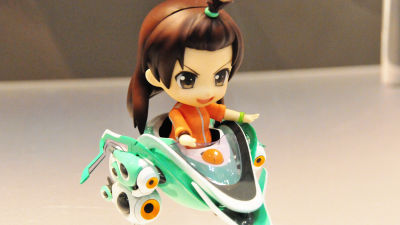
The anime series '
The special stage inside the Wonder Festival venue looks like this.
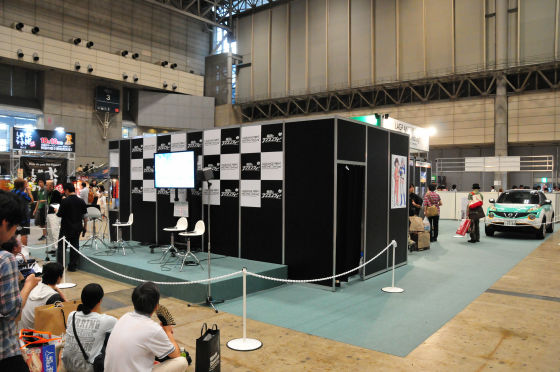
The event was held from 4:15 PM to 5:00 PM, and people started arriving one after another as soon as it started.

◆ 'Lagrange: The Flower of Rinne' Designer Talk Show
Keisuke Hirota (hereinafter Hirota):
As this is a designers' talk show, we have two people in charge of mecha design for
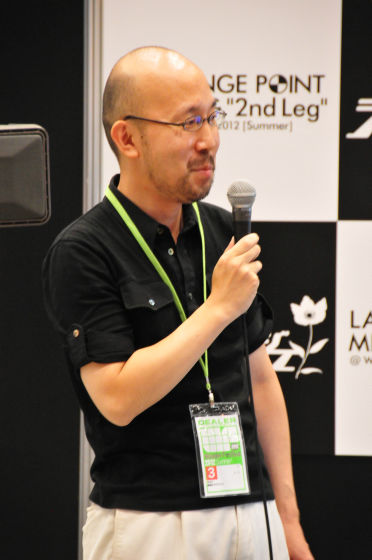
Takashi Osuda (hereinafter Osuda):
thank you.

Hiroyuki Kikuchi (hereinafter Kikuchi):
thank you.

Hirota:
And this time we have one guest, who is the Ovid design and coloring supervisor, who goes by the obvious pseudonym August 32nd (Sunny), but today we have invited him to reveal his real name,
(Applause from the audience)
Hirota:
Please say something.
Masahiko Asano (hereinafter Asano):
Well, I'm Masahiko Asano, a model culture writer and label producer for ' Wonder Showcase ,' who has been working under the very confusing pseudonym 'August 32nd (Sunny).' Nice to meet you.

Hirota:
Why did Asano use a false name?
Asano:
There were two reasons. First, I often work with Model Graphix, so if I used my real name,
Hirota:
Asano-san, you're also involved with a racing car magazine, aren't you?
Asano:
Well, sort of. Yes.
Hirota:
So, have you had any experience with anime before?
Asano:
Wait a minute... It's a little one.
Hirota:
Would ' Gundam Sentinel ' be easy for everyone to understand?
Asano:
Those who understand will understand.
Hirota:
People who know Gundam Sentinel... Ah, there are a few of them. What role did Gundam Sentinel play?
Asano:
Hmm. I was somehow the general director and producer.
Hirota:
Mr. Osuda and Mr. Kikuchi, are you aware of this story?
Osuda:
I had already been watching Gundam Sentinel a lot.
Kikuchi:
I knew about Sentinel, but unfortunately not so much.
Hirota:
So, how did you feel when you first heard that Asano would be involved in direction?
Osuda:
Well, it was like a frenzy...I was so happy.
Kikuchi:
No, I had no input at all, but Osuda-san said to me, 'He's an amazing person, so just listen to him.' So I thought I'd listen to everything.
Hirota:
So, in that situation, Asano will be in charge of everything...
Asano:
Well, that's an exaggeration to say. Basically, rather than repainting it to my liking, I'm helping to bring out the correct values that are buried there.
◆Opid's commitment to coloring
Hirota:
So first, let's talk about coloring.
Asano:
As for the coloring, I did the coloring for all three Vox units from scratch, and for Kikuchi's De Metrio unit, I tuned the colors. I said things like, 'Why don't we make this a little more brown?' or 'Why don't we make it a little more orange?', but that was basically all done by Kikuchi. As for the Villajulio unit, Osuda and I did it together. By the way, the reason why the colors are switched in the color scheme of version 2 of the Villajulio unit is because the white and red parts are reversed, but to tell you the truth, it was originally this color. At the design stage, Osuda designed it. However, the color scheme was too similar to that of the Vox unit, and it looked like an allied unit.

Hirota:
There's a lot of white area.
Asano:
Yes. So, we decided to reverse them. However, the original one we were going to reverse was also cool, so we asked Director
large:
I also loved F1, so I immediately said, 'That's a good idea. Let's do it.'
Hirota:
Regarding Vox, even though we say it's green, the density of the color on the wings and around the neck is slightly different. That kind of coloring design is used for Aura, but it's not the same for Linfa and Ignis.

Asano:
That's right. The densities of Linfa and Aura are reversed. The reason is that if you do the same thing with Linfa as with Aura, Linfa, which has a stronger hero color, will look stronger. No matter how you look at it, Linfa will look like the main unit. That's why we intentionally put light colors around it to make it look less impressive. We also switched the positions of the densities to make it clear that Linfa is actually a sub-unit.
Hirota:
So, Ignis is orange. It doesn't have any shades.

Asano:
It's not that good. People who are knowledgeable about coloring and design think of orange in terms of three axes... hue and, what's it called, brightness and saturation? If you increase the brightness of orange, it turns into a skin color. Conversely, if you decrease the brightness, it turns into a brick color. It's actually impossible to create variations of orange. So, when it comes to orange, it's fine to use a single color.
Hirota:
So, that's the kind of trial we're doing...
Asano:
That's right. The design of these three units was colored with a graphic design approach. And if I might add one more thing, especially for Vox, the example of color usage is '
Hirota:
This was done with Gundam-style robots in mind...
Asano:
Of course. I mean, not ' Gundam SEED ' but ' Mobile Suit Gundam 00 '... I think it was the mobile suit colorings that were all so amazing. There were so many that hadn't been great before that, so I was looking at them and getting frustrated, thinking 'Why are the colorings so bad?' So I said, 'Let me do the work of a graphic designer.'
◆Direction by car designers and August 32nd (Sunny)
Hirota:
I'll talk about the details of the work later. But first, I think Osuda-san and Kikuchi-san drew quite freely in the first competition. What do you think about that? I think that was the time when they had to decide on the shape for the anime. There are some very early designs in the book LAGRANGE DESIGNS , and for example, Kikuchi-san's design is quite monster-like. Can I ask you about that?

Kikuchi:
Yes, yes, yes. That's right, the initial design was pretty much... like an image sketch. I drew things like the silhouette of the shoulders and the entire silhouette of the limbs, but when I looked at it from the perspective of someone who designs cars, I thought, 'It looks a bit like a monster.' Asano pointed that out to me, and I felt like I was able to firmly establish my position as a car designer.

Kikuchi:
So we did a lot of tuning... but the most difficult part was the Teneritas. The evolution of the Teneritas from a monster to a car design was both the most difficult and the most fun.

Hirota:
What did you think, Osuda-san?
Osuda:
During the first competition, the theme was always 'transformation allowed,' so I had to make it transform, and of course the robot form and the flying form both had to look cool, so I struggled a lot with that. Among the initial settings, there was also talk of using sound.
Hirota:
Sound.
Osuda:
I think there was something like a speaker on the shoulder, and that's a remnant of that.

Hirota:
The yellow one, right?
Osuda:
Yes. That's true for most robots, but when you look at it from the side, a lot of them have a flimsy design. We wanted to characterize that, and when it transforms into flight mode, these four parts should look like they have bombs attached under the wings, so we focused on that when designing it.
Hirota:
The reason I asked you this is because there's a book from 12 years ago called 'MEAD GUNDAM,' which contains all of the details of the design of '
Asano:
If you buy that on Yahoo! Auctions now, it's really expensive.
Hirota:
How much is it?
Asano:
You definitely can't buy it for less than 5,000 yen.
Hirota:
Well, it was through that kind of trial and error that the design for Turn A Gundam was created. This time, I'd like to look at Asano's direction work from that perspective. First of all, this. What kind of instructions were there for this?
Asano:
Well, well. I just wrote down in detail each and every detail that I thought would have suited the aircraft design better.
Hirota:
Can you see the letters here? Can you read them? This is at the top...
Asano:
The instructions at the top are awful.
Hirota:
'I know this is a weird way to put it, but it's terrible. I feel like 'Kikuchi is the one who doesn't understand the truth about the Kirius machine the most.' The Kirius machine is a 'Johnny's-style machine' that is made up solely of 'beauty of style' and 'sharpness and speed.'' Using the word 'Johnny's-style' to describe a robot...

Asano:
That's terrible.
Kikuchi:
All of Asano's emails are terrible (laughs), but he always inspires me with words that really hit me right in the gut, and they're more stimulating than working at a company. I realized that this is how creativity comes about.
Hirota:
This might be difficult to answer, but at work...
Kikuchi:
No one says that to me at work.
Asano:
You see, Kikuchi-san is the type of person who grows when praised.
Hirota:
I'm not praising you, I'm not praising you (lol)
Asano:
That's why I don't understand the concept of coaching by praising others to help them grow. My coaching style is to hit and hit and help them grow.

Hirota:
He continued, 'The stylishness that is unique to the Kirius aircraft has been lost.' I can't believe he's saying that...
Osuda:
If it were me, I would have said, 'That's enough.'
Kikuchi:
I was worried about it many times. During this period, I was also receiving a lot of advice from Osuda-san.
Asano:
When we were working on the design, whether we were receiving designs from Kikuchi or returning them, we always included Osuda in the CC, so he was able to see all of our interactions.
Kikuchi:
He would say things like, 'This is what I think,' in a calm manner. During my breaks at work, we would talk about things like, 'What do you think of Asano's comments?' and I would start to feel more at ease.
Osuda:
Only during breaks.
Hirota:
Just the two of us during recess.
Kikuchi:
yes.
Osuda:
I agree.
Hirota:
Next up, the Izo machine. What's this...?

Asano:
The instructions in the top right corner are also terrible.
Hirota:
It clearly says, 'The nozzle is far too rough (this is like the world of Super Robot Wars,
Kikuchi:
It's written there. I'm the type of person who will go that way if I let my guard down for a moment, so I had to include my own efforts as a car designer in this. This sort of thing has happened from time to time. For example, it's a small slit. It's not here, but I drew two slits. They're like beeps. Then Asano-san commented back, 'Kikuchi-san, a car has three slits, right? Change it to three.' He said that two slits isn't car design. I didn't really understand that part (laughs), but I thought I'd just go along with it for the time being.

Asano:
No, because what I specifically told Kikuchi-san was, 'Please actively act as a car designer.' That is, when
Hirota:
I see. Next, this is from earlier...

Asano:
This is the initial draft by Mr. Osuda mentioned earlier.
Hirota:
Mr. Osuda, you were also thinking about the coloring of the Alvirium for version 2, right?
Osuda:
That's right. Yes. After that, Asano pointed out that the color scheme was too close to the main character's mobile suit.
Hirota:
So, this is the revised proposal.

Asano:
At that time, I still didn't know how to use Photoshop very well. The way I painted colors was kind of messy. I didn't really know how to use the area selection function. At that time, I was still drawing by hand.
Hirota:
Handwritten.
Asano:
The letters. At that time, I hadn't thought of a pen name yet, so I would just sign it with something like M.A. So when I made the special edition of
Hirota:
I see. So this is to make him look like a villain.
Asano:
Rather than making it look like a villain, the change was made simply to eliminate the similar atmosphere between the main character's machine and Aura and the others.
Hirota:
this is…….

Asano:
This was from Osuda-san, who suggested that we use the nickname 'fiddler crab' to match the coloring of the Villa Giulio's special machine, but I thought it might be a little weak. So I came up with three ideas and said, 'How about something like this?'

Hirota:
'If we think of the Vira machine as Char's personal machine, then his minion machines could be like mass-produced Zakus, and they could also be green'... That's a pretty blunt statement.
Asano:
I thought green might be a bit too much, so I gave up on it.
Hirota:
In the end, it turned out to be the blue one in the bottom right.
Asano:
When I presented this to Osuda-san and asked him, 'Which of these do you like best?' he immediately replied, 'Blue is good.' If you look closely, these two colors are Max and Miria.
Hirota:
Be aware of that change...
Asano:
No, I wasn't really conscious of it. I was simply thinking about it from a graphic design methodology perspective, and it just clicked with me, 'Oh, thinking about it carefully, this is the color scheme that Max and Miria would use.' Strictly speaking, it's not true; my blue is a better color than Max's blue.
Hirota:
(laughs) Um, next is the weapons... the armaments. Were you the first to draw these armaments, Asano-san?

Asano:
No, it was Osuda-san. This was one of the most satisfying moments in this job, but Director Suzuki requested that the fiddler crab hold a lance. Osuda-san first designed the lance, saying, 'Maybe something like this,' but it had a blade like a utility knife coming out of the end, so it didn't really look like a lance. A lance is, after all, a spear, so I thought it would be a bit weird if it didn't look like a spear, so I asked him, 'How about this?' and redrawn it. I thought it would be cool if a beam came out of it. I drew it myself, and I thought, 'I could make it look cooler, but it just wasn't working... Whatever, I'll just send it!' and sent it by email. He polished it up to look really cool, and I was so happy, thinking, 'Wow, my idea turned out so cool!'

Hirota:
This is what happened.

Asano:
That awful thing...
Osuda:
As for the exchange we just had, Asano-san gave me the idea, even if it was just a rough sketch, so I was able to draw it like this. I think it would have taken a long time to get to that point if I had started from scratch.
Asano:
I'm not a designer either, so I wasn't sure how far I could go, but Osuda-san didn't mind it at all and seemed happy about it, so we ended up using Photoshop quite a lot in the latter half.
Hirota:
Next, this is...

Asano:
This is more about the coloring. The design for the Diselmine dedicated machine was progressing in this state, but one day I suddenly thought, 'This isn't interesting.' So I just added red. I suggested the color to Osuda, 'How about something like this?' Basically, this is

Hirota:
Yes, this is... a weapon.

Asano:
This is because the weapons up until then were a bit thin.
Hirota:
This is the weapon called Spider Shot that was used by Officer Arashi in
Asano:
I thought it might be easier to understand if I occasionally put up something like that, something for otakus. Like downloading something from the internet and sticking it up.
Hirota:
By the way, this is a garage kit, so it's not an original product of Tsuburaya Productions (lol). I just wanted the shape to be easy to understand. So what did we end up talking about?
Asano:
It was just something like, 'That's how it feels.' Osuda-san saw it and did a great job of processing it.
◆ Garage Kit Competition 'Design Award' Results Announced
Hirota:
Today, Wonder Festival starts at 5pm, so we'll be running until the very end, but we'll also be holding a garage kit competition, where we'll be showcasing the works selected by Osuda-san and Kikuchi-san, and the winners will receive illustrations by Osuda-san and Kikuchi-san. Now, here's the design award from Kikuchi-san.

Kikuchi:
Yes. Next, takahilow, who created Libertas. I feel like he made it 120% cooler than the 3D model I had in mind, and I particularly liked the depiction of the back.

Hirota:
Yes, that's right.
Kikuchi:
I was very impressed by this. Of course, there was someone else who came in second place, too. They were very bright and very good, but I'm sorry, but this time I'll go with this one. I was very impressed.

Hirota:
Is there anyone who has made this? Ah, there is.
venue:
applause
Hirota:
Well, see you later. Next up is Osuda-san.
Osuda:
Yes. Sparrow SA, who created 'Vox Aura.' It's a very sharp arrangement, and I understand that it was made specifically for flight mode, but the way it's deformed in this cool direction is amazing. I knew the main character was a girl, so I made the corners rounded and intentionally made it soft, but if I left it alone, I would also end up in this direction. So I empathize, and I think if I were to draw it now, it would probably turn out like this.

Hirota:
I see.
Asano:
What's cool about this is that the nose has not been simply lengthened, but rather shortened.
Osuda:
That's right. It was very interesting.

Hirota:
Has anyone created this piece? ...Isn't there?
Asano:
I just met him while I was selecting the artists for the Wonder Showcase.
Hirota:
If you contact me later, I'll send you the illustration drawn by Osuda-san, so yes. We still have a little time. It's amazing how you can create your own interpretation with a garage kit like this. Making the mechanics is especially hard. Figures may be hard too, but I feel like there aren't many people making mechanics these days. Hasegawa is releasing an egg plane, but I'd like them to release the Vox and the three De Metrios as proper scale models. I want people to find more meaning in the fact that they're kits... injection kits. With today's Gunpla, it's not like you just stick a sticker on it and it's done, it's shaped, and it moves. I want people to touch it with their hands to get a feel for the shape.
◆Lagrange is trying to think fundamentally
Asano:
Just as Hirota-san just said, hands are an extremely important input device, and anyone who makes plastic models will understand this, but if you make a Zaku, for example, you can start drawing Zaku the next day. That's why you can't understand complex designs like these Vox models just by looking at them in 2D. That's why you need

Hirota:
And yet they release all sorts of things. I won't say the titles, but they release this and that... why isn't there a Lagrange?! Frankly, I think the hobby industry is pathetic. Why aren't they releasing this? It's strange. I mean, the two car designers worked so hard and were criticized by Asano, and it's hard to imagine the hobby industry just passing it by. After all. They should release a proper injection kit. The place that released it is a hero.
Asano:
Actually, the reason why I offered to help with the mecha design for Lagrange this time was because I interviewed Director
Hirota:
That's where we need to change our mindset. It's fine to think, ' The RX-78 is great,' but is it okay to keep it that way forever? Basically, during Turn A Gundam, the RX-78 was likened to the Zero fighter . Since the RX-78 became the Zero fighter, it's fine to make RX-78 models, just like Zero fighter models are still being made today. But there's no path forward from there. It never comes out no matter how much time passes. The lines are a little different, or the equipment is different, or something. So, I think Lagrange is a trial run, a trial of fundamental rethinking. I want everyone to see that more. The production announcement at Nissan Hall last October attracted a lot of attention, but since then, it hasn't received much attention.
Asano:
Actually, when it comes to Lagrange's design, almost no one has any say about it, whether it's good or bad. In fact, if they could just say 'this is why it's not good,' that would be totally fine.
Hirota:
It's okay to dislike something. But it's not just that you don't like it because it looks like ' Psalms of Planets Eureka Seven ' or ' Genesis of Aquarion ,' but you can say things like, 'I don't like that line,' or 'I don't like this color,' and be honest about it. Otherwise, you won't be able to train yourself, and neither will your fans, or the industry as a whole. Everyone should feel free to say what they want to say.
venue:
(lol)
Hirota:
That's what I think, but maybe that's just my own assumption (laughs).
Asano:
No, I think that's absolutely true.
Hirota:
I feel like people are overthinking things, thinking, 'It would be bad to say this,' or 'Won't people make fun of me if I praise this?' Even if Osuda and Kikuchi weren't that overconfident, the results they achieved are still significant.
Kikuchi:
Well, I think that when the anime industry and our industry work together to create a work like this, the general public might take it lightly, thinking, 'Oh, Nissan and an anime company are working together again, just to create some buzz,' but there were a lot of hurdles to overcome to get to this point, and we had to ask Asano for help, and there were also a lot of extremely tough conversations from the anime production side. I want everyone to know that what has come out here is truly a result that cannot be achieved easily.
Asano:
It may seem strange to say this about a show that's still on the air, but I think that in 10 years, everyone will probably realize, 'That was amazing.'
venue:
(lol)
Hirota:
Mr. Osuda, what is it...?
large:
I hope that's the case (laughs).
Hirota:
It will still be around in 10 years. In fact, we will be the ones to leave it there. Don't worry.
Asano:
wonderful.
venue:
applause
Hirota:
If they don't do that much, this trial won't be worth it at all. I'm saying this because this is a model exhibition, but I want to say, why don't you at least bring out one of your models?
Asano:
We have Mr. Yoshihiro Kano from Bandai's Hobby Division here with us.
venue:
(lol)
Hirota:
Well, by all means.
Asano:
In the Hobby Division, Kano was also in charge of developing the Master Grade Turn A Gundam and the R3 Walker Gallia.
Hirota:
Yes, thank you, Kano-san.
Kano:
Sorry, I got called out of the blue...

Hirota:
I'd like to hear a round of applause from those here who would like to see Vox Aura released on the Master Grade label.
venue:
applause
Kano:
That's unfair. Even though I've been called here and told that, I have no right to decide whether or not to sell the product.
Hirota:
What do you think personally?
Kano:
Personally, I think it's an interesting design. However, there's one thing that's different from when it came to Syd Mead: there was the Mead Gundam book I mentioned earlier, but even looking at it, we couldn't figure out the correct value, so we thought we could come up with the final correct value. But with this design, the correct value was already there the moment we saw it, so frankly, I thought that even if it wasn't Bandai, we could surely produce the same thing. That's the big difference. So, to be honest, when it was presented, I didn't understand the significance of Bandai doing it.
Hirota:
Well, maybe in 10 years...
Kano:
I don't know. There are many people who say, 'It would be better if it was done like this,' and if this design evolves further, something might happen. Sorry, this is really personal... I'm not trying to take the company's side, though.
Hirota:
No, no. As Kano-san said, what do people think of this design? If you think it's good, spread the word, but if you think it's bad, it would be easier for the manufacturers if you said so. It's just as Kano-san said. So don't keep quiet, everyone. The program is still going on, and unless you clearly express your opinions, saying what you think is good and what you think is bad, the manufacturers won't take action. It feels like if you express your opinions, the manufacturers might take action.
◆ Garage Kit Competition 'Grand Prize' Results Announced
Hirota:
Oh, sorry, we're going to announce the grand prize for the garage kit competition now.
venue:
(lol)
Hirota:
We're talking about mechanics now!
Osuda:
It came out of nowhere (laughs).
Hirota:
This is amazing, it's well made. Zenko's 'Ran'. Most figures are often disguised with paint, but this one was done properly. So instead of just looking at pictures of figures, you should see and touch the real thing.

Asano:
It's a forced connection... (laughs)
venue:
(lol)
Hirota:
You can't understand it unless you touch it. You can't be satisfied with just a photo. When it comes to figures or any other three-dimensional objects, you have to touch them. That's the easiest way to understand them. In a sense, you can't be fooled by the paint. You have to touch them. That's true for all models. So, instead of buying models in boxes and just stacking the boxes, keep making them.
Asano:
So, in reality, you don't need to paint it. You can assemble it, input the information by hand, and create a design in your head.
Hirota:
That's why fingers are input devices, and they allow you to assemble three-dimensional objects in your head. Even if the model in front of you disappears later, it will still be remembered in your head. This is a human ability, so let's experience it for ourselves. Model lovers.
Osuda:
Both Kikuchi and I built models when we were little, and learned about the three-dimensional feel of them with our hands, which has led us to the work we do today. We really want people to touch them.

Asano:
I'm pretty good at drawing Gundam mobile suits, but I can't draw the
Hirota:
That's it. Even aspiring designers tend to think they understand three-dimensional objects when they see them in photos or on a monitor, but don't be satisfied with just looking at the monitor; you should touch them and make them. The person who makes a garage kit is the most impressive. There are over 80 people taking part in the competition today, and to me, they're all impressive. The person who makes it is more impressive than the people who look at it and judge it. I hope everyone doesn't forget that. Yes. And that's all for this talk show.
venue:
(lol)
Asano:
thank you very much.
Kikuchi:
thank you very much.
Osuda:
thank you very much.
Hirota:
Finally, an announcement: Speaking of the anime, episode 4 will be aired tonight on TOKYO MX .

Hirota:
There's also a merchandise corner here, and there's a Lagrange Designs item signed by Osuda and Kikuchi. You should really buy this. You should buy it. You should buy it! I bought it with my own money. It's signed, so there are only a limited number available. Please be sure to pick one up on your way home. Thank you.

Osuda:
thank you.
Kikuchi:
thank you.
Hirota:
Well then, thank you very much, Mr. Osuda and Mr. Kikuchi. Finally, please say one more thing each.
Kikuchi:
The biggest thing for me this time was, of course, being able to see the Libertas that I chose earlier, and I was really moved by it. Even though I'm a car designer, it's not easy to just finish something with your own sketches; a car design only comes into existence when there's a modeler who makes it. Since I only drew pictures, the design wasn't in 3D, so I was really interested in how it would turn out in three dimensions. And they really put a coolness into it that was beyond my imagination, so for now I just want to say 'thank you.' I'm grateful.
Osuda:
I was also looking forward to coming here today and seeing the model, but I was really happy to see someone I didn't know at all recreate the design I drew. I was really moved. I was impressed by how much thought went into making it.

Hirota:
Yes. Thank you both. This concludes the talk show. Thank you very much.
Related Posts:

